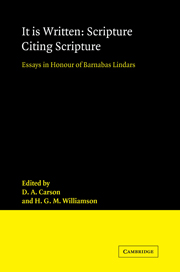Book contents
- Frontmatter
- Contents
- Preface
- Biographical note
- Abbreviations
- 1 An assessment of recent developments
- THE OLD TESTAMENT IN THE OLD TESTAMENT
- BETWEEN THE TESTAMENTS
- THE OLD TESTAMENT IN THE NEW TESTAMENT
- 11 Text form
- 12 Matthew
- 13 Mark
- 14 Luke/Acts
- 15 John and the Johannine Epistles
- 16 The Pauline literature
- 17 Hebrews
- 18 James, 1 and 2 Peter, Jude
- 19 Revelation
- Indexes
18 - James, 1 and 2 Peter, Jude
Published online by Cambridge University Press: 16 January 2010
- Frontmatter
- Contents
- Preface
- Biographical note
- Abbreviations
- 1 An assessment of recent developments
- THE OLD TESTAMENT IN THE OLD TESTAMENT
- BETWEEN THE TESTAMENTS
- THE OLD TESTAMENT IN THE NEW TESTAMENT
- 11 Text form
- 12 Matthew
- 13 Mark
- 14 Luke/Acts
- 15 John and the Johannine Epistles
- 16 The Pauline literature
- 17 Hebrews
- 18 James, 1 and 2 Peter, Jude
- 19 Revelation
- Indexes
Summary
These four letters contain a wide variety of types of use of the Old Testament, some of them, as we shall see, indistinguishable from contemporary Jewish use of Scripture, and most of them heavily indebted to traditions of Jewish exegesis. In order to keep the discussion within bounds, I shall select some important types of use of the OT: formal exegesis akin to the Qumran pesharim, in Jude and i Peter; OT figures as ethical and religious models, in James and 2 Peter; paraenetic use of Scripture, in 1 Peter; and interpretation of the Mosaic law, in James.
In my view (argued for Jude and 2 Peter in Bauckham, 1983), Jude and James derive from early Palestinian Jewish Christianity, and 1 and 2 Peter from Roman Christianity just before and not long after the death of Peter. I therefore discuss them in that order, which I think likely to be the order in which they were written, but the discussion is largely independent of these views of date and provenance, though it may help to confirm them.
JUDE
The short letter of Jude contains perhaps the most elaborate and carefully composed piece of formal exegesis in the style of the Qumran pesharim to be found in the NT, though it has only recently been recognised as such (Ellis, 1978; Bauckham, 1983). This passage, which I shall call a midrash (using the word loosely to refer to a passage of formal exegesis, not necessarily in the form of the rabbinic midrashim), is vv. 4–19, of which v. 4 forms the introductory statement of theme.
- Type
- Chapter
- Information
- It Is Written: Scripture Citing ScriptureEssays in Honour of Barnabas Lindars, SSF, pp. 303 - 317Publisher: Cambridge University PressPrint publication year: 1988
- 5
- Cited by

